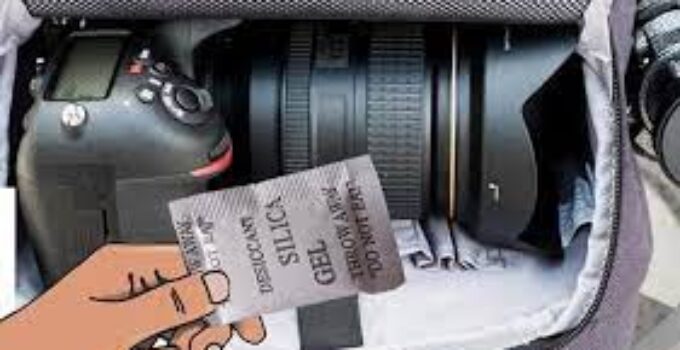Should i put silica gel in my camera bag?
Have you ever wondered how to keep your camera gear in pristine condition despite fluctuating humidity? Silica gel packets could be your answer.
These small, moisture-absorbing beads play a crucial role in preserving the longevity of your camera equipment.
By placing silica gel in your camera bag, you can help prevent moisture build-up that can lead to mold, corrosion, or damage to delicate electronic components and lenses.
Silica gel works by absorbing excess humidity, creating a drier environment within your bag.
This simple yet effective solution ensures that your gear remains in optimal condition, ready for your next photographic adventure.
Here how to make a bean bag for camera support?
Should i put silica gel in my camera bag?
Yes, placing silica gel packets in your camera bag is a good idea. Silica gel absorbs moisture, which helps prevent humidity-related issues like mold, mildew, and lens fogging.
Cameras and lenses are sensitive to moisture, and excess humidity can damage delicate components or degrade image quality.
Silica gel packets act as a simple, effective way to control the environment inside your bag, especially in humid climates or if you frequently move between different temperature and humidity levels.
To maintain their effectiveness, periodically replace or dry out the silica gel packets according to the manufacturer’s instructions. This small step can help prolong the life of your equipment and ensure it remains in optimal working condition.
Is it safe to keep silica gel in a bag?
Is it worth to put silica gel in your camera bag?
Yes, it’s worth putting silica gel in your camera bag. Silica gel helps manage moisture levels, which is crucial for protecting sensitive camera equipment.
Excess humidity can cause lens fogging, mold growth, and corrosion on electronic components, potentially damaging your gear.
By absorbing excess moisture, silica gel helps prevent these issues and keeps your equipment in better condition. This is particularly important in humid climates or when moving between different environments with varying moisture levels.
Silica gel is inexpensive and easy to replace, making it a cost-effective way to prolong the life of your camera gear. Just ensure the packets are in good condition and replace them periodically to maintain their effectiveness.
Overall, adding silica gel to your camera bag is a simple precaution that can help safeguard your equipment from moisture-related damage.
Can you put silica gel in your camera bag?
Things to know before putting silica ge in your camera bag
7 Tips to put silica gel in your camera bag
1. Choose the Right Type of Silica Gel
Select silica gel packets specifically designed for moisture control in electronics or camera equipment. These packets are often more effective and safer for delicate gear.
Here, how to clean billigham canvas?
Avoid using silica gel that’s intended for other purposes, as it may contain additives that could be harmful to your equipment.
Look for packets that are labeled as “moisture absorber” or “desiccant” and ensure they are free from any harmful chemicals. Opt for packets that are appropriately sized for your camera bag to maximize their effectiveness without overcrowding the space.
2. Inspect Packets for Damage
Before placing silica gel in your camera bag, carefully inspect each packet for any signs of damage.
Damaged packets may leak granules that can potentially harm your equipment. Ensure the packets are intact, sealed, and free from tears or holes. If you find any damaged packets, discard them and use new ones.
Regularly checking the condition of the packets helps maintain the effectiveness of the moisture control and protects your gear from potential issues caused by spilled granules.
3. Position Packets Strategically
Place silica gel packets in strategic locations within your camera bag to maximize their effectiveness.
Avoid placing packets directly on your camera or lenses, as they could cause abrasions or interfere with functionality. Instead, use compartments or pouches to keep the packets separate from your equipment.
Distribute packets evenly throughout the bag to ensure consistent moisture absorption. Consider placing some packets in the corners or less accessible areas where moisture is likely to accumulate.
4. Use the Right Quantity
The number of silica gel packets needed depends on the size of your camera bag and the level of humidity in your environment. For small to medium-sized bags, 2-4 packets are typically sufficient. For larger bags or extremely humid conditions, you might need more.
Overloading the bag with packets can make it cumbersome and reduce their effectiveness. Follow the manufacturer’s recommendations or use a few extra packets if you’re unsure, but avoid excessive quantities that could disrupt the organization of your gear.
Here, how to put on a tripod strap on a camera bag?
5. Replace Packets Regularly
Silica gel packets lose their moisture-absorbing effectiveness over time, so it’s important to replace them regularly. Depending on your environment, this could be every few months or as needed. Some packets are reusable and can be dried out in an oven according to the manufacturer’s instructions.
Keep track of how long the packets have been in use and replace them if they appear discolored or if you notice increased humidity inside your bag. Regular replacement ensures optimal protection for your equipment.
6. Monitor Humidity Levels
Occasionally check the humidity levels inside your camera bag to ensure that the silica gel packets are performing effectively. You can use a small hygrometer to measure the humidity within the bag.
If you notice high humidity levels despite having silica gel packets, it may be a sign that the packets need replacement or that additional packets are needed. Monitoring humidity helps you maintain the right conditions for your equipment and prevents potential damage from excessive moisture.
7. Store Packets Properly When Not in Use
If you need to store silica gel packets for future use, keep them in a dry, airtight container to prevent them from absorbing moisture prematurely. Exposure to air can reduce their effectiveness. Store the container in a cool, dry place away from direct sunlight or high humidity.
Proper storage ensures that the packets remain effective when you need them and helps prolong their lifespan. Label the container if necessary to easily identify the contents and remember when the packets were stored.
7 Steps to put silica gel in your camera bag
7 Methods to put silica gel in your camera bag
Should i put silica gel in my camera bag for photography?
Should i put silica gel in my camera bag nikon?
Yes, placing silica gel in your Nikon camera bag is a smart precaution. Silica gel packets absorb moisture, helping to prevent issues like lens fogging, mold, and corrosion that can affect your camera and lenses.

Nikon cameras, like any other high-precision equipment, are sensitive to humidity, which can damage internal components and degrade performance over time.
By using silica gel, you create a controlled environment within your bag that protects against excess moisture. This is especially important if you’re in a humid climate or frequently travel between different environments.
Ensure the silica gel packets are intact and placed in a way that doesn’t directly touch your equipment. Regularly check and replace the packets to maintain their effectiveness.
Overall, using silica gel is a simple yet effective way to extend the life and maintain the performance of your Nikon gear.
Related faq’s
I got it wrong! How does the little silica gel bag do its work?
How much silica gel should I put in my dry box?
The amount of silica gel needed for a dry box depends on its size and the level of humidity. As a general guideline, use about 1 ounce (28 grams) of silica gel for every 1 cubic foot (28 liters) of space.
For larger dry boxes, you may need multiple packets. Ensure the packets are evenly distributed throughout the box to effectively absorb moisture.
If you live in a particularly humid environment, consider using more silica gel or adding extra packets for enhanced protection. Regularly check and replace the silica gel to maintain optimal moisture control.
How useful is silica gel for protecting SLR cameras against condensation from changes in temperature?
Silica gel is quite useful for protecting SLR cameras against condensation caused by temperature changes. As temperatures fluctuate, moisture can condense on your camera’s lenses and internal components, potentially leading to damage like mold growth or corrosion.
Silica gel absorbs excess humidity within the camera bag or storage area, helping to create a stable, dry environment that reduces the risk of condensation.
By maintaining lower humidity levels, silica gel helps protect your camera gear from moisture-related issues, ensuring better performance and longevity.
However, it’s important to regularly check and replace the silica gel packets to ensure continued effectiveness.
Is camera at risk of condensation in cold temperatures if never removed from bag?
Yes, a camera can still be at risk of condensation in cold temperatures, even if it remains in its bag. When a cold camera is moved to a warmer environment, moisture in the air can condense on the camera’s surfaces, including lenses and internal components.
This can occur if the bag itself is not designed to control humidity effectively. To mitigate this risk, allow the camera to acclimate gradually to the new temperature by leaving it in the bag for a while before opening it. Using silica gel in the bag can help absorb moisture and reduce condensation risks.
Can I put silica gel packets to my DSLR camera bag to keep the camera moisture free
Yes, placing silica gel packets in your DSLR camera bag is an effective way to keep your camera moisture-free.
Silica gel absorbs excess humidity, helping to prevent issues such as lens fogging, mold, and corrosion that can affect your camera and lenses. This is especially useful in humid environments or when transitioning between different temperature conditions.
Ensure the packets are in good condition and placed in areas where they won’t come into direct contact with your camera gear. Regularly check and replace the packets to maintain optimal moisture control and protect your equipment from potential damage.
How do I keep my camera dry with the help of silica gel packets?
What should I do with the silica gel bag in my backpack? Should I keep it there?
Yes, you can keep a silica gel bag in your backpack to help manage moisture. Silica gel absorbs excess humidity, which can prevent issues like mold and dampness inside your backpack.
Place the silica gel packet in a non-obtrusive spot where it won’t interfere with your items. If you frequently encounter humid conditions or if your backpack is exposed to varying temperatures, keeping the silica gel bag in your backpack is beneficial.
Regularly check the packet’s condition and replace it if needed to ensure it remains effective. This simple addition can help protect your belongings from moisture damage.
Silica crystals inside a camera bag.. good or bad ?
Silica crystals inside a camera bag are generally good for protecting your equipment. They absorb excess moisture, reducing the risk of condensation, mold, and corrosion, which can damage your camera and lenses.
Silica crystals help maintain a dry environment, especially in humid or varying temperature conditions. However, ensure the packets are intact and do not leak granules, as these could potentially scratch or damage your equipment.
Place the silica packets in compartments or pouches within the bag to avoid direct contact with your gear. Regularly check and replace the packets to maintain effective moisture control.
How much silica gel do I need to dry a camera?
To effectively dry a camera, use approximately 1 ounce (28 grams) of silica gel for every cubic foot (28 liters) of space around the camera.
For a typical camera bag, this usually translates to 2-4 packets, depending on the bag’s size and humidity levels. Ensure the packets are evenly distributed and positioned away from direct contact with the camera.
If your camera is in a small, enclosed space, fewer packets might suffice. Regularly monitor the silica gel’s effectiveness and replace or dry out the packets as needed to maintain optimal moisture control.
Should I keep Silica Gel packets in my Camera Case?
Yes, keeping silica gel packets in your camera case is a good idea. Silica gel helps absorb excess moisture, preventing issues like lens fogging, mold growth, and corrosion that can damage your camera and lenses.
Place the packets in compartments or pockets within the case to ensure they don’t come into direct contact with your gear. This helps maintain a dry environment inside the case, especially in humid conditions or when transitioning between different temperatures.
Regularly check and replace the silica gel packets to ensure they remain effective in protecting your equipment.
Anyone else use Silica Gel satchels in their camera bag to remove moisture?
Do I need to use silica gel packs when storing lens in?
Yes, using silica gel packs when storing lenses is highly recommended. Silica gel helps absorb excess moisture, preventing issues such as lens fogging, mold growth, and corrosion that can damage sensitive lens components.
By maintaining a dry environment inside your storage case or bag, silica gel helps ensure your lenses remain in optimal condition.
Place the silica gel packs in compartments or pouches within the storage area, avoiding direct contact with the lenses. Regularly check the packs and replace or dry them out as needed to ensure effective moisture control and protect your valuable equipment.
Can I put silica gel in my camera bag?
Yes, you can put silica gel in your camera bag. Silica gel absorbs excess moisture, helping to prevent issues like lens fogging, mold growth, and corrosion that can damage your camera and lenses.
Place the silica gel packets in various compartments or pouches within the bag, ensuring they do not come into direct contact with your equipment. Regularly check the packets for saturation and replace or dry them out as needed to maintain their effectiveness.
Using silica gel is a simple and effective way to keep your camera gear dry and in good condition, especially in humid or changing environments.
What does silica gel do for camera?
Silica gel helps protect a camera by absorbing excess moisture, which prevents issues such as lens fogging, mold growth, and corrosion.
It creates a drier environment within the camera bag or storage case, reducing the risk of damage caused by humidity and condensation. By controlling moisture levels, silica gel helps maintain the camera’s performance and longevity, especially in humid or fluctuating temperature conditions.
Regularly checking and replacing the silica gel packets ensures they continue to effectively manage moisture and protect your camera and lenses from potential damage.
Should I keep the silica gel in my bag?
Yes, keeping silica gel in your bag is beneficial. Silica gel absorbs excess moisture, helping to prevent issues like mold, mildew, and dampness, which can damage the contents of your bag, including electronics and personal items.
This is particularly useful in humid environments or when your bag is exposed to varying temperatures. Place the silica gel packets in different compartments of the bag to ensure effective moisture control.
Regularly check the packets and replace them as needed to maintain their effectiveness. Overall, silica gel helps keep your bag’s contents dry and in good condition.
How do you take care of your cameras?
To take care of your cameras, follow these steps: regularly clean the lens with a lens brush and microfiber cloth to remove dust and smudges.
Store your camera in a dry, dust-free environment, ideally in a padded case or bag. Use silica gel packets to control moisture and prevent mold. Avoid exposing your camera to extreme temperatures or direct sunlight.
Check and clean the sensor periodically, and ensure that batteries are removed if storing the camera for an extended period. Regular maintenance and proper handling will help prolong the life and performance of your camera equipment.
Will this be enough in preventing mold? And should the lens
Yes, these steps are effective in preventing mold. Regular cleaning and proper storage reduce dust and moisture, which are key factors in mold growth.
Using silica gel packets helps control humidity inside the camera bag or storage area, further reducing the risk of mold.
Additionally, ensure the lens is cleaned and dried before storing, and avoid storing the camera in humid or damp conditions.
For lenses, use a lens cleaning brush and microfiber cloth to remove dust and smudges. If mold does develop, have the lens and camera serviced by a professional to prevent damage and ensure thorough cleaning.
Is a camera bag enough to avoid condensation?
A camera bag alone may not be sufficient to completely avoid condensation, especially in environments with significant temperature and humidity fluctuations. While a well-constructed camera bag provides some protection, it doesn’t control humidity inside the bag.
Using silica gel packets can help absorb excess moisture and reduce the risk of condensation. Additionally, allowing your camera to acclimate gradually to temperature changes by keeping it in the bag before exposure can help prevent condensation.
Combining a high-quality camera bag with silica gel and proper handling practices will offer better protection against condensation and moisture-related issues.
Conclusion
Yes, putting silica gel in your camera bag is highly recommended. Silica gel effectively absorbs excess moisture, which helps prevent issues such as lens fogging, mold growth, and corrosion that can damage your camera and lenses.
By maintaining a drier environment inside the bag, silica gel provides added protection, especially in humid conditions or when transitioning between temperatures.
Ensure the silica gel packets are intact and properly distributed within the bag, and replace them regularly for optimal effectiveness. Combining silica gel with proper camera handling and storage practices will help safeguard your equipment and extend its lifespan.










When I initially commented I clicked the “Notify me when new comments are added” checkbox and now each time a comment is added I get several emails with the same comment. Is there any way you can remove people from that service? Many thanks!